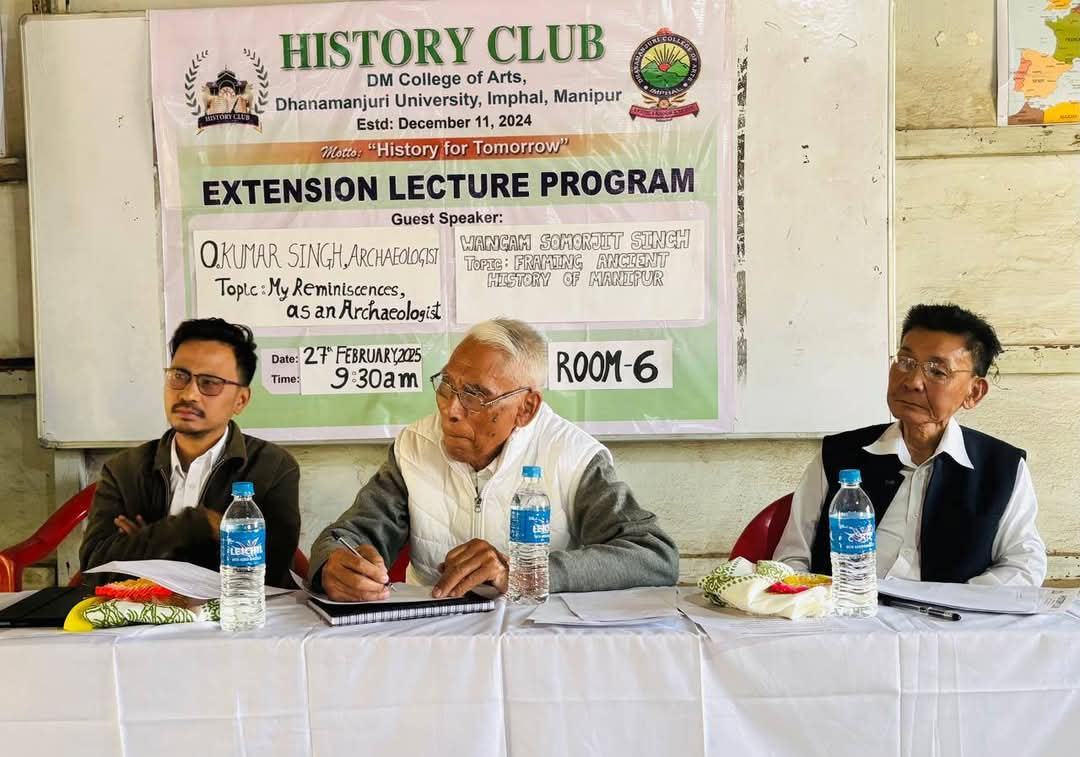History Club Organises Lecture on Manipur’s Archaeology and History
The History Club of the Department of History, D.M. College of Arts, Imphal, organised a lecture programme on archaeology and the history of Manipur at the college today. The event was graced by the college Principal, Dr. S. Lanchenba Meetei, Head of the History Department Samuel Duidang, eminent archaeologist Okram Kumar Singh, and historian Wangam Somorjit.
Speaking at the gathering, Dr. Lanchenba emphasised the importance of academic engagements on college campuses and the need to make students aware of Manipur’s rich and vibrant history. He also recalled the glorious history of D.M. College and its contributions to the state.
The highlight of the event was the lectures delivered by two eminent scholars, Okram Kumar Singh and Wangam Somorjit.
Insights from Eminent Archaeologist Okram Kumar Singh
Okram Kumar Singh, the most reputed archaeologist of Manipur, delivered a lecture on *”My Reminiscences as an Archaeologist.”* He spoke about major excavations he conducted at prominent prehistoric sites in Manipur, including Kangkhui Cave, Songbu Cave, Tharon Cave, and Sekta. He also highlighted significant findings, such as golden masks, bronze and silver relic caskets, and other artefacts often associated with Buddhism. Using a PowerPoint presentation, he explained the historical importance of these discoveries and reiterated the urgency of protecting important archaeological sites in the state.
Okram Kumar Singh began his teaching career at D.M. College before serving as the Principal of D.M. College of Commerce and Superintendent of Archaeology. His contributions extend beyond Manipur, having participated in archaeological explorations in Garo Hills, Meghalaya (1966) and the excavation of Bhimbetka prehistoric cave in Madhya Pradesh (1975). His research findings have been published in various journals and books. Recognising his contributions, he was felicitated as a Veteran Scientist of Manipur in 2002 by the Manipur Association for the Promotion of Science. His notable works include Archaeological Researches in Manipur, Archaeology in Manipur, Neolithic Stone Tools in Manipur, Stone Age Archaeology in Manipur, and Pottery through the Ages.
Reinterpreting Manipur’s History: Lecture by R.K. Somorjit
The second lecture was delivered by historian R.K. Somorjit on “Framing Ancient History of Manipur.” He challenged the conventional geographical interpretation of Manipur as a mere northeastern Indian state and emphasised its historical role as a crucial link between South Asia, East Asia, and Southeast Asia.
“Manipur is strategically positioned between mainland India, Bangladesh, Myanmar, and China. It has been a melting pot of cultures, geopolitics, and historical events, including being a major theatre of the Second World War. The Battles of Imphal and Kohima (March 8 – July 18, 1944) were among the most crucial battles of the war, leading to Japan’s defeat by Britain,” he stated.
Discussing the Silk Route, he highlighted Manipur’s role in ancient trade networks.
“The Silk Route is often seen as connecting China, Central Asia, India, and Europe. However, the Southern Silk Route passed through Manipur, linking Yunnan in China to India and Myanmar, and further connecting to Vietnam, Thailand, and Laos. Maritime routes extended this network to the Gulf of Thailand, the Strait of Malacca, and India,” he explained.
Somorjit also discussed archaeological findings in Manipur, including burial sites at Sekta, golden masks, Buddhist artefacts, and mandala-shaped ramparts discovered across the state.
R.K. Somorjit is the Director of the Advanced Research Consortium Library & Archives and has authored two books: Manipur: The Forgotten Nation of Southeast Asia and The Chronology of Meetei Monarchs (1666 CE to 1850 CE).
The lecture programme was attended by faculty members, research scholars, and postgraduate and undergraduate students of the college.

